How can I start with organic farming?
The step-by-step approach
The procedure of conversion of a farm commonly consists of three steps. In a first step, it is recommended to collect information on appropriate organic farming practices. In a second step, the most promising organic practices should be tried out on selected plots or fields to get familiar with. In a third step, only organic procedures should be implemented in the entire farm. Support from an experienced extension officer or a farmer is usually very helpful to give guidance in the process.
1st Step: Good information first
Successful organic farming requires considerable knowledge on the functioning and the possibilities of management of natural processes. Interest in learning about the possibilities to support natural processes to sustain and improve harvests is essential for successful organic farming.
Farmers who are interested in adopting organic farming practices are recommended to get in contact with farmers in the area, who already practice organic farming to learn from them. Some farmers may be good at making compost, some at growing green manures, and some at making plant or manure tea. Learning from experienced farmers allows to get first-hand experience under local conditions, and thus to learn about the advantages and potential challenges related to implementing organic methods.
Basically, farmers who are interested in converting their farm to organic agriculture, need to know:
- How to improve soil fertility.
- How to keep crops healthy.
- How to best increase diversity in the farm.
- How to keep livestock healthy.
- How to give value to organic products and how to successfully sell them.
The information can be obtained from different sources depending on the circumstances. Potential sources are experienced organic farmers, training courses offered by institutions such as non-governmental organisations or the national organic agriculture movement (NOAM) or from radio programs.
Find more details on information sources here.
2nd step: Trying out organic practices
After having collected information about the requirements, the potential and the main practices related to conversion, farmers should start to learn from their own experience on their farms. To minimize risks of crop failure and losses of animals, and avoid frustrating overload, farmers are recommended to implement organic practices step-by-step to a limited extent, selecting specific practices at a time and testing them on selected plots or selected animals only.
But which practices should one choose to start with? As would seem natural, farmers should start by applying practices that are of low risk and investment, require little specific knowledge, limited additional labour, and with high short-term impact. Examples of recommended interventions include:
Mulching - Covering the soil with dead plant material is an easy way to control weeds and protect the soil in annual crops. This practice can be implemented into most existing cropping systems. The main question may be, however, where to get appropriate plant material from.
Intercropping - Growing two annual crops together, commonly a leguminous crop like beans or a green manure crop in alternating rows with maize or another cereal crop or vegetable is a common practice in organic farming to diversify production and maximize benefits from given land. In intercropping, special attention must be paid to avoid competition between the crops for light, nutrients and water. This requires knowledge on arrangements, which promote growth of at least one of the crops.
Composting - Application of compost to the fields can have a major impact on crop growth and yields. To start compost production, farmers will need enough plant materials and animal manures, if such are available. In case such materials are scarce, farmers would first have to start producing plant materials on the farm by sowing fast growing leguminous plants that build a lot of biomass, and by introducing some livestock on the farm for manure production, if this proves appropriate. To get familiar with the process of making compost, farmers should be instructed by an experienced person. Proper compost production requires some knowledge and experience and additional labour, but is low in investments.
Green manuring - The practice of growing a leguminous plant species for biomass production and incorporation into the soil may be new to most farmers. Nevertheless, this practice can greatly contribute to improvement of soil fertility. Green manures can be grown as improved fallows, as seasonal green manures in rotation with other crops, or in strips between crops. Proper green manuring first requires information on appropriate species.
Sustainable pest management - Introduction of sustainable pest management requires good knowledge on the pathogen cycle and its interaction with the crop, on influencing factors and potential natural enemies. Farmers, who use synthetic pesticides, may start by introducing weekly monitoring of pest development in their crops applying recommended procedures. Pesticides should then only be used, when the threshold level of the crop is reached. Instead of using synthetic pesticides, farmers should try out recommended bio-control agents or natural remedies, perhaps only on a limited surface first.
Appropriate seeds and planting material - Use of healthy seeds and planting materials, and robust and/or improved cultivars can make a big change in crop production. This practice may require some information on selection of seeds and planting materials including availability of improved varieties and seed treatments.
Planting of leguminous trees - In perennial crop plantations such as banana, coffee or cocoa, planting of leguminous trees such as gliricidia, calliandra, and sesbania may improve the growing conditions of the fruit crop by providing shade, mulching material and nitrogen through nitrogen fixation. In addition, some leguminous trees provide good fodder for livestock. This practice requires some knowledge on shade and space requirements of the tree crops and thus on ideal planting patterns for the leguminous trees.
Growing farm-own animal feeds - To improve available feeds for the livestock, farmers may grow grasses and leguminous fodder crops around, between other crops or in rotation.
Terraces and soil bunds - Construction of terraces and soil bunds along the curves of hills is a key measure for soil conservation. This practice builds the foundation of further improvement to soil fertility on slopes. It is of high relevance, but requires much labour and some specific knowledge for appropriate implementation.
3rd Step: Full conversion to organic farming
In a third step, implementation of organic practices throughout the entire farm should be considered, once sufficient experience with different practices has been gained. As soon as organic practices are implemented throughout the entire farm, a farmer can claim to be an organic farmer.
Commonly, consistent application of organic practices marks the beginning of a long process of improving the production system:
(i) improving soil fertility based on the recycling of farm own organic materials and enhancement of farm own biomass production,
(ii) encouraging positive interactions between all parts of the production system (the farm ecosystem) to enhance self-regulation of pests and diseases,
(iii) optimizing the balance between feed production and livestock.
Farming organically also means continuously learning from personal observation, from outside experiences, sharing experiences with other organic farmers and implementing new information on the your farm, making it increasingly more sustainable.
Discussion on how to start implementation of organic practices
Ask the farmers, which organic practices they already know and apply on their farms. Give an overview of the practices and discuss together with the farmers, which practices are the most appropriate and promising to start with. Do the selected practices concern soil fertility management, pest and disease management, weed management, animal husbandry, or another range of production?
How to proceed with marketing of the farm products
Organic farmers who produce for the market are interested to know the market potential and how to get access to organic markets. Giving best value to high quality organic products is a major concern of organic farmers and needs specific techniques. Marketing products as organic also requires certification of the farm. No organic certification is required, if the farm products are not sold as organic. The decision to certify the farm as organic should be linked to the possibility of marketing a relevant share of the farm products as organic with a premium price. The premium price should cover the certification costs.
Application for certification can be made, when the entire farm is managed organically. Depending on the organic standards there is a defined transition or conversion period of one to three years. During this time, depending on the standards, the farm products must either be marketed as non-organic, or they can be marketed as organic products originating from a farm in conversion. Most customers in export markets, however, request organic products that originate from farms that have already achieved the conversion period.
Marketing organic products involves considerable personal initiative. To access domestic and local markets, farmers need to communicate the value of their products to local traders and customers. This may involve inviting them to the farm and explaining the principles of organic production and showing them advantages of the organic approach for nature and the positive impact on product quality. Traders and customers buy organic products based on a certificate from an organic certification body. Local supermarkets may require registration as a member of the National Organic Agriculture Movement (NOAM) as an additional guarantee of the farmer’s commitment to organic agriculture. In that case, it is the responsibility of the NOAM to ensure that their registered farmers are producing according to organic requirements.
In case the farmers want to sell to export markets through a trader, there may be specific regulations to comply with. Selling to export markets requires proper guidance by the NOAM or the exporting company.
Find further information on the procedure to gain organic certification and approaches to market organic products here.
Sharing experiences on conversion
If possible, invite some farmers to share their experiences on the steps towards converting to organic farming. The following questions may provide you guidance for the discussion: How did they first get in contact with organic farming? What motivated them to apply organic practices? What recommendations would they give to farmers concerning the procedure? At which stage did organic certification become relevant?
Discussion on marketing of farm products
Discuss with the farmers the potential of marketing their farm products as organic. Discuss the advantages and difficulties selling products to the different markets.
Which crops to grow during conversion?
Looking at the organic farm as being ‘one organism’, the focus does not lie on cultivating specific crops only. Rather, the focus is on choosing crops that can easily be integrated into the existing farming system and will contribute to its improvement. But the choice also depends on the farmer’s knowledge on the right management of the crops, their contribution to a diverse family diet or their demand in the market. Besides growing crops for food, farmers may need to grow leguminous cover crops to provide high-protein feed for livestock and to be used as green manures to feed the soil. Planting trees for shade, as windbreak, for firewood, feed, mulching material or for other uses, can be recommended in most situations.
Criteria for crop selection during conversion:
a. In a first place organic farmers should grow enough food for the family. But they may also want to grow crops for the market to get money for other family needs. The farmers should also grow crops that contribute to improvement of soil fertility. Farmers who keep livestock need to grow pasture grass and legumes.
b. Basically, farmers should select crops with low risk of failure. Cereals and legumes such as maize, sorghum, millet, beans and peas are especially suitable for conversion, since they cost little to produce, generally have moderate nutrient demands and are robust against pests and diseases. In addition, many of the traditional crops can be stored and sold in domestic markets. High-value short term crops, such as most vegetables, are more delicate to grow and highly susceptible to pest and disease attack. Therefore, they should not be grown on a larger scale, unless the farmer can endure some losses in harvest.
c. The crops to grow for sale should include crops that can be sold at the farm gate, at the roadside market or can be transported directly to nearby markets in urban centres. Choosing the right crop to sell on the market may require some market information. Decision making for crops for local or export markets requires detailed information from traders or exporters on the crops, requested varieties, quantities, qualities and season.
d. High-value perennial crops such as fruit trees take at least 3 years until the first harvest from the date of planting. This makes them appropriate crops for the conversion period. For new plantations, species and varieties must be carefully selected to suit the organic market and production requirements. For conversion of an existing orchard, it might be necessary to replace old existing varieties, if they are very susceptible to diseases and the product quality does not match with the market requirements.
e. The success of a crop will also depend on provision of favourable growing conditions. The better a crop variety matches local soil and climate conditions, and is tolerant or resistant to common pests and diseases, the better it will grow.
f. Planting of hedges and agroforestry trees can be valuable to help establish a diverse farming system.
g. Growing leguminous green manures provides nutrients to the soil. Green manures do not provide immediate income, but in the long-term, they make the soil fertile and productive for the future.
Many farmers want to see quick results and often ask how long it takes for organic crops to grow. Organic farming does not aim to make crops grow faster. Crops will grow faster and larger when they have better growing conditions than before. Although conventionally grown crops can be made to grow faster by intensive use of synthetic fertilizers and sprays, organic crops are nurtured to grow at their normal, natural rate in order to be less susceptible to pests and diseases and build up good physical and nutritional structure. However, organic farmers do a lot to make their crops grow healthy and to produce good yields.
Learn more about soil fertility management here.
Discussion on appropriate crops
Ask the farmers, which crops they presently grow and discuss with them, which crops would be most suitable under organic management:
- Which crops contribute to a diverse family diet?
- Which crops respond to market demands?
- What price can you obtain on the market? Are there many competitors?
- Do the crops serve to feed livestock?
- Do the crops fertilize the soil, or do they offer shade for other crops or firewood?
- Which crops grow well together? Which crops contribute to a diverse and stable production system?
Avoiding contamination
It is in the responsibility of organic farmers to protect the organic fields from being sprayed with synthetic pesticides. Even if the neighbour is not farming organically, an organic farmer can grow organic foods and fibres. To avoid pesticide drift from neighbouring fields onto the crops, organic farmers should safeguard the organic fields by using any of the following measures:
- Planting of natural hedges on the boundary to neighbouring fields can avoid the risk of pesticide spray drift through wind or run-off water. The wider the border area around the fields, the better.
- To avoid runoff from upstream fields, organic farmers should divert the water away or talk to the farmers upstream about how to work together to minimize the risk of contamination through water. Organic farmers who are interested in saving nature, should share their knowledge and experiences with neighbours with the aim of helping them to either adopt organic farming practices or to minimize the risk of contaminating nature.
Contamination risk from Genetically Modified Organisms (GMO)
Genetically modified seeds and planting materials are produced by transferring isolated genes from plants, animals or microorganisms into the crop genome, circumventing pollination and crossing natural barriers. This is seen as a violation of the integrity of the cell as the smallest living entity and is not accepted in organic farming. Genetically modified products should, therefore, not be used in organic farming, and organic farmers should protect their production against any GMO contamination. However, with the increased use of GM crops in the conventional farming systems, the risk of GMO contamination is expected to increase. Species which cross-pollinate, such as rapeseed or maize, or insect pollinated crops, such as soybean or cotton, are at a higher risk of being contaminated by a nearby genetically modified crop. Species that are mainly vegetative pollinated such as potatoes, cassava or banana are at lower risk of GMO contamination. Besides the genetic contamination, there is also a risk of physical contamination caused by GMO residues along the production and market chain, if GMO and organic products are not properly separated.
Recommendations to farmers for reducing the GMO contamination risk:
- Use either personally selected seeds or get organic or untreated seeds that were not genetically modified from neighbouring farmers you and are certain do not use GMO seeds and are not surrounded by GM crops of conventional farmers (distance of at least 1 km). If you use seeds from a trader, make sure that he is registered and can confirm where the seed is derived from. Check that he is not involved in GM production and multiplication. Ask your trader for a certificate confirming GM free seeds and inquire about the trader’s involvement in the GM-seed market.
- Check for the breeding habits of the specific crops you are interested in. Most cross breeding species such as maize can disperse by wind or bees to distances of up to 1 to 3 km.
- Seeds of some crops can survive for 5 to 20 years in the soil. Therefore, precautions must be taken that no GM crops have been planted on land that shall be used for organic production.
- Create protective safety (buffer) zones around your fields to reduce the risk of GMO pollen dispersal, if GM crops are cultivated in this region. Isolation distances between GM crops and organic fields should be established, about 2-3 times larger than those required for seed production for a given species. For dispersal of critical GM crops such as maize, the isolation distance should probably not be less than 2 to 3 km. This will reduce GMO dispersal by pollen to a great extent. For wind pollinated crops, like maize, borders or hedges with tall plant species, such as sugarcane or trees, can additionally prevent cross-pollination with GM crops.
- Avoid any physical GM contamination by using sowing and harvesting machines, transporters, processing and storage facilities not used for GM crops. In case you have to use the same machines, thorough cleaning is necessary. Do not store organic products next to GM products.
- GMO free regions should be encouraged wherever possible, especially for own seed production.
- If you are uncertain about the quality of your seed, have it checked for GM contamination.
Discussion on GMO contamination risk
Assess the farmers’ understanding of GMOs by asking the following questions:
- Have you ever heard of genetically modified organisms?
- Which GMO crops are grown locally, if any?
- Do you know which cultivars are GMO?
- Do you know which tra-ders sell GM crops and which traders propagate, processe and store only GM free crops?
- What do farmers say about GMO crops?
- Do you know if your neighbours cultivate GM crops?
- Do you know where you can check your seed or your crop if it is GMO contaminated?
Discuss with the farmers measures of prevention of contamination of organic crops.
The conversion process for organic certification
From the point of view of certification, the period of conversion starts when a farmer manages his farm in accordance with the organic regulations. This starts when a farmer renounces use of synthetic pesticides, fertilizers and GMO or treated seeds. Stepwise reduction of agrochemicals cannot be considered part of the conversion period. An important step of the conversion period is the recognition of the farm as organic by a certification body. The conversion period is accomplished after the third year or third harvest is certified as organic. Nevertheless, even if the formal conversion period is accomplished, the adaptation of the farm is not finished. It usually takes several years to establish a well-balanced farm ecosystem and restore natural soil fertility.
According to the basic regulations of IFOAM, the International Federation of Organic Agriculture Movements, the entire farm must be managed organically. This is true for all private organic labels as well. Whereas most governmental regulations allow farmers to certify a part of the farm as organic and still manage the rest of the farm conventionally. Such separation, however, involves risks and, therefore, also some restrictions and constraints. Generally, for small farms, only conversion of the entire farm can be recommended, as the farm unit would become too small to enable establishment of a diverse production system, allow proper crop rotation and introduction of livestock.
The procedure of inspection and certification
- Once a farmer or a farmer group has taken the decision to convert his or their farm(s), the farmer or the farmer group can take the first step towards certification by contacting the certification body and asking for information on the certification procedure, the costs and the subscription forms for certification. This can happen at any time of the year. The contact between the farmer and the certification body may also be established through an agricultural adviser. Following the farmer’s contact, the certification company will give the farmer the application forms for starting the official conversion process, and the organic regulation manual to make sure that the farmer has all information available on the requirements of organic agriculture. The farmer is then asked to get familiar with the regulations and sign the application. Together with the application, the farmer provides detailed information about the farm to be certified.
- Based on the forms, the certification body sets up a contract and forwards it to the farmer. The farmer signs the contract, declaring commitment to comply with organic regulations and the conditions of the certification procedure including the annual visit, the duty of record keeping and payment of certification fees.
- The conversion can start at 1st of January or during the year when the crop season starts (for example flowering of fruit trees or soil preparation for vegetable crops). When converting, the farmer must start keeping records, such as purchase and application of inputs (fertilizers, pest and disease management agents, seeds) as well as marketing of products (see here for more information). The records will serve as one of the references on crop and animal husbandry for certification.
- Every year the farm is inspected by an inspection officer or by a member of the participatory control system (see here for more info). During inspection, the farmer informs the officer about the management of the crops and of livestock and his or her successes and failures. The officer consults the records and takes a look at the fields and the stables. Inspection also includes an estimation of the risk of contamination of the farm through synthetic pesticides and GMO from neighbouring fields. In case products are transformed on the farm, the procedures will also be discussed. The more open and honest the communication by the farmer is, the better any possible misunderstandings can be avoided.
- Based on the farm-visit the inspection officer writes the inspection report and forwards it to the certifiers for analysis and final certification decision. If the farm complies with the organic regulations, the farmer receives the certificate, if necessary with additional recommendations for the management. In case of non-compliance with requirements, for example, following the use of synthetic pesticides, the certifier is not authorized to issue a certificate (for details see here).
- With the certificate, the farmer may now sell his products as organic in conversion during the first 2-3 years. After the third year only, the farmer can sell his products as full organic. The EU regulation provides that the farmer has to sell the first harvest as conventional (not even as organic in conversion).
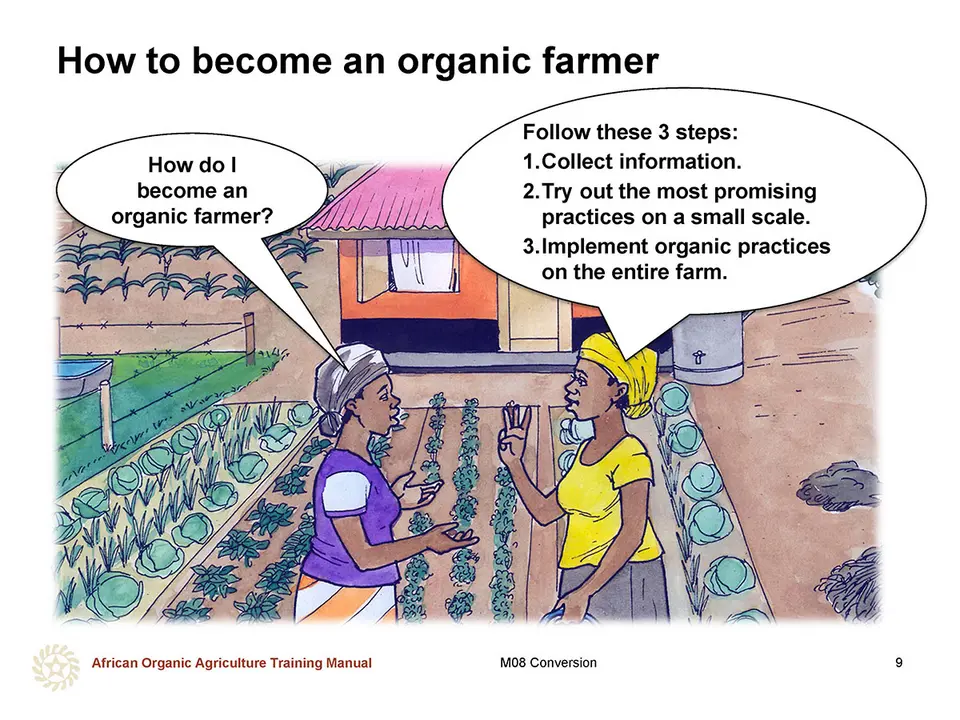
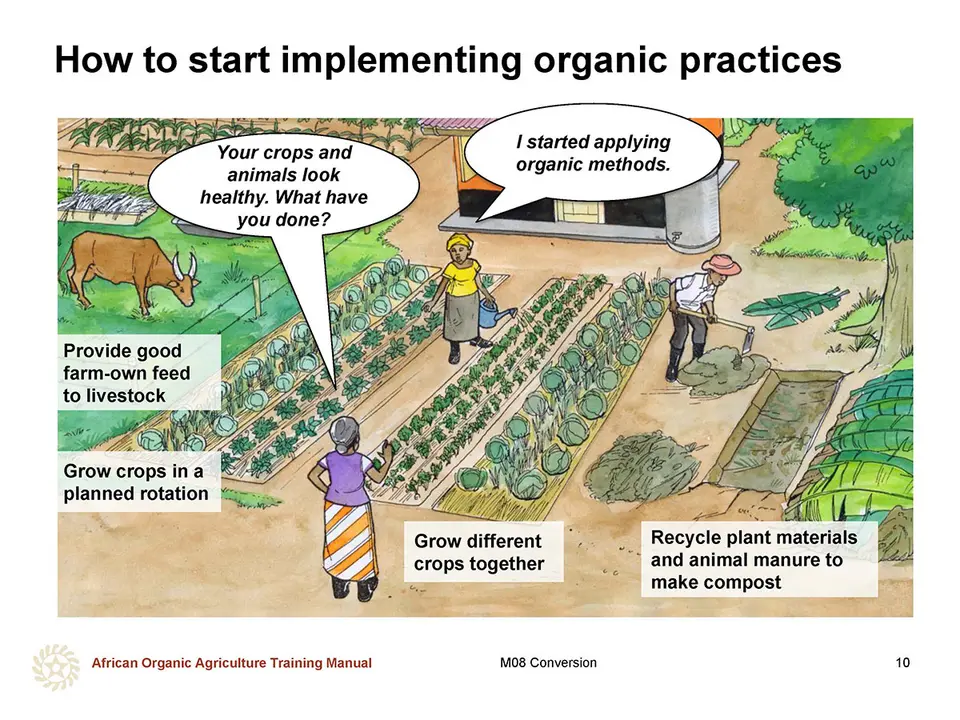
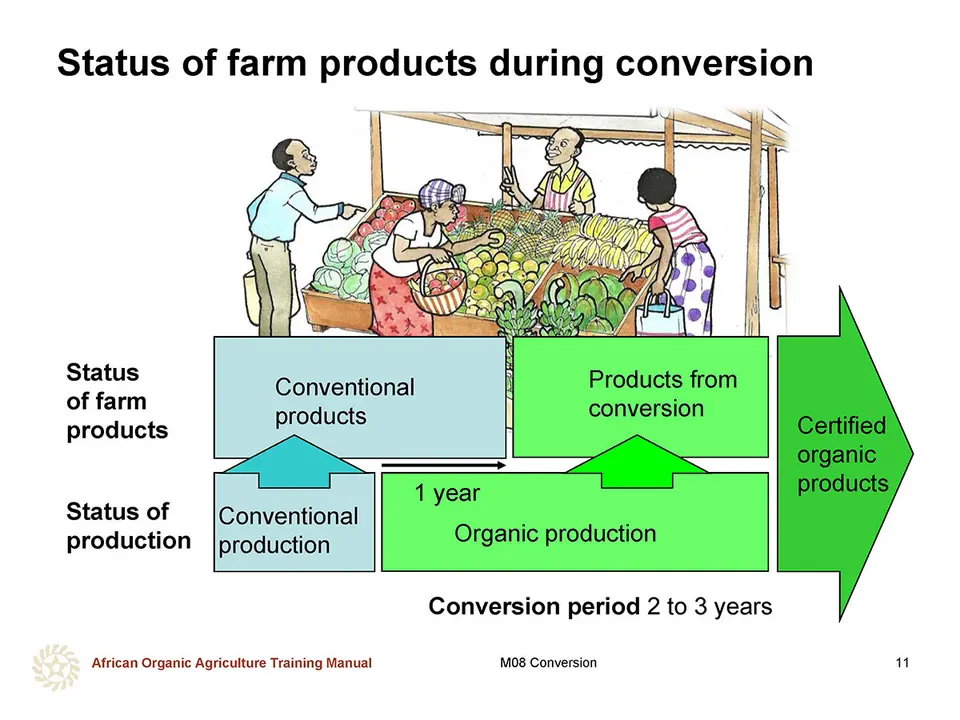
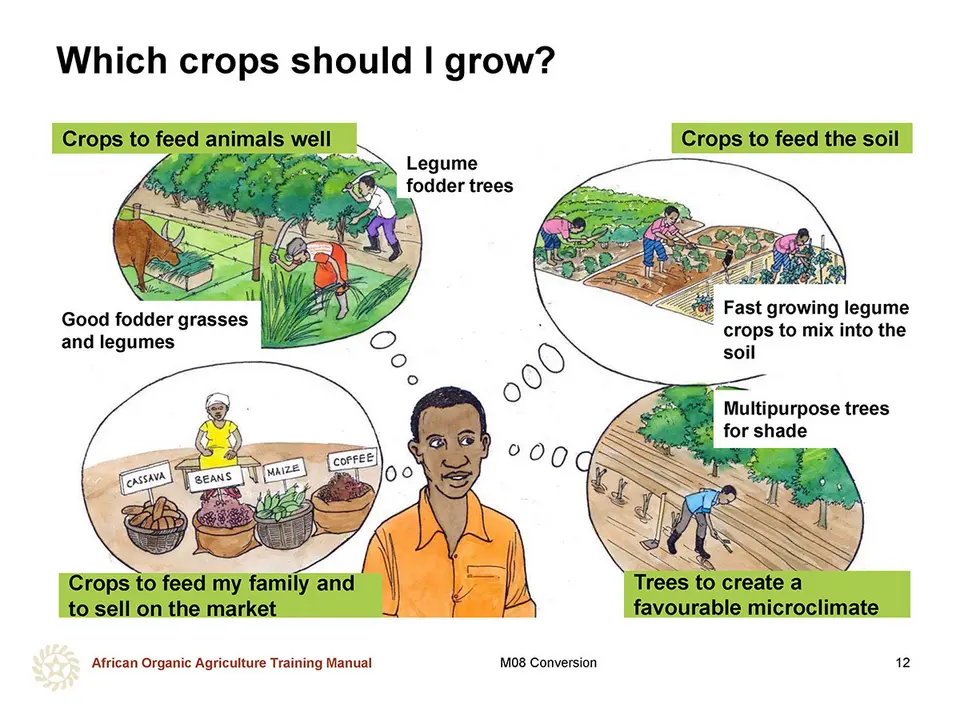
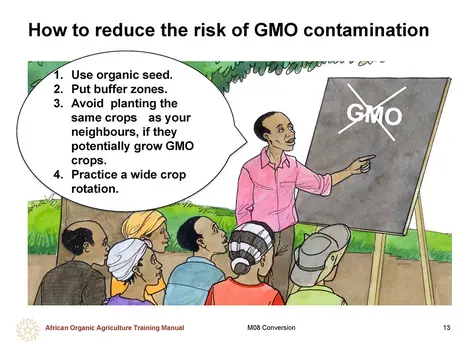
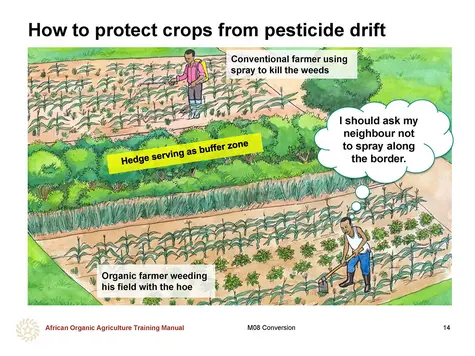
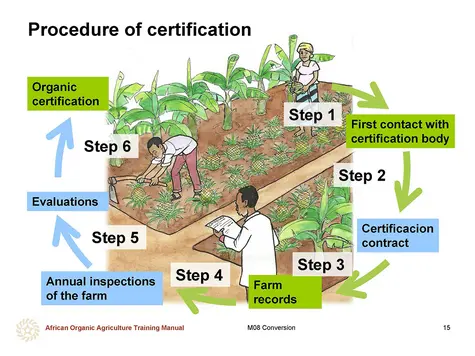
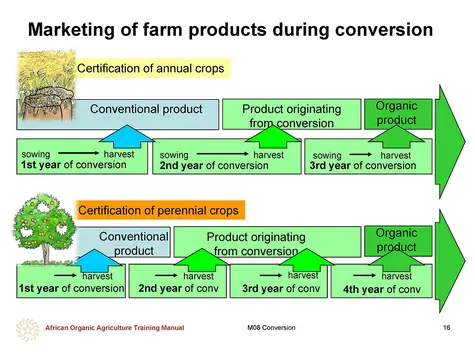
 tap and then scroll down to the Add to Home Screen command.
tap and then scroll down to the Add to Home Screen command.